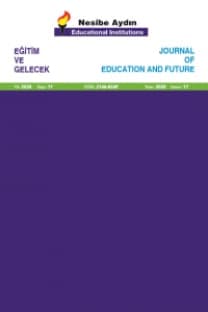Fen ve Öğrenme Alanlarındaki ve Bilişsel Alanlardaki Puanların Türkiye'de Bulunan Alt ve Üst Düzeydeki Okullara göre İncelenmesi
-
-
TIMSS 2011, low-performing schools, high-performing schools, science cognitive domains item difficulty,
___
- Bosker, R.J., & Witziers, B. (1996, April). The magnitude of school effects. or: Does it really matter which school a student attends? Paper presented at the Annual Meeting of the American Educational Research Association, New York, USA.
- Coleman, J. S., Campbell, E., Hobson, C., McPartland, J., Mood, A., Weinfield, F., & York, R. (1966). Equality of educational opportunity. Washington, DC: U.S. Government Printing Office.
- Gonzalez, E.J., & Miles, J.A. (2001). TIMSS 1999 user guide for the international database. International Association for the Evaluation of Educational Achievement. Boston, MA.
- Greenwald, R., Hedges, L. V., & Lane, R. D. (1996). The effects of school resources on student achievement. Review of Educational Research, 66, 361-396.
- Hanushek, E. A. (1986). The economics of schooling: Production and efficiency in public schools. Journal of Economic Literature, 24, 1141-1177.
- Hanushek, E. A. (1989). The impact of differential expenditures on school performance. Educational Researches, 18, 45-51.
- IAE (2012) International Association for the Evaluation of Educational Achievement.
- Joncas, M. (2007). TIMSS 2007 Technical Report: Chapter 5 TIMMSS 2007 Sample Design. International Association for the Evaluation of Educational Achievement. Boston, MA.
- Konstantopoulos, S., (2006). Trends of School Effects on Student Achievement: Evidence from NLS:72, HSB:82, and NELS:92. Teachers College Record, 108, 2550-2581.
- Martin, M.O, Mullis, I.V.S, Foy, P., & Stanco, G.M. (2012). TIMSS 2011 International Science Report. Chestnut Hill, MA: TIMSS & PIRLS International Study Center, Boston College.
- Martin, M.O., Gregory, K.D., & Stemler, S.E. (2000). TIMSS 1999 technical report: IEA’s repeat of the Third International Mathematics and Science Study at the eighth grade. Chestnut Hill, MA: Boston College.
- Mortimore, P., Sammons, P., Stoll, L., Lewis, D., & Ecob, R. (1988). School matters. Berkeley, CA: University of California Press.
- Mullis, I.V.S, Martin, M.O, Ruddock G.J., O'Sullivan, C.Y., & Preuschoff, C. (2009). TIMSS 2011 Assessment Frameworks. TIMSS & PIRLS International Study Center Lynch School of Education, Boston College.
- OECD (2007). PISA 2006: Science Competencies for Tomorrow’s World, Executive Summary, 2007.
- Schmidt, W.H., Jorde, D., Barrier, E., Gonzalo, I., Moser, U., Shimizu, K. (1996). Characterizing pedagogical flow: An investigation of mathematics and science teaching in six countries. Dordrect, The Netherlands: Kluver.
- Teddlie, C., & Stringfield, S. (1993). Schools make a difference: Lessons learned from a 10- year study of school effects. New York: Teachers College Press.
- TIMSS (2013). Released Items. International Association for the Evaluation of Educational Achievement. Boston, MA.
- Yildirim,H.H., Yildirim, S., Ceylan, E., Yetisir, M.I. (2013). Turkiye Perspectifinden TIMSS 2011 Sonuclari. Turk Egitim Dernegi Tedmem Analiz Dizisi I, Ankara.
- Fen Öğrenme Alanlarındaki ve Bilişsel Alanlardaki Puanların
- Türkiye'de Bulunan Alt ve Üst Düzeydeki Okullara göre İncelenmesi
- ISSN: 2146-8249
- Yayın Aralığı: Yılda 2 Sayı
- Başlangıç: 2012
- Yayıncı: Nesibe Aydın Eğitim Kurumları
Anlamsal Wiki: Bilgisayar Mühendisliği Eğitiminde İşbirlikçi Öğrenme Ortamı İçin Bir Araç
Gürcan ÇETİN, Rukiye KARAKIŞ, Aydın ÇETİN
Bestecilik Eğitimi Bakımından Ulvi Cemal Erkin'in Keman Konçertosunun Formal Analizi
Üniversiteler ve Teknokentlerde Eğitim Alanında ARGE Projesi Yürüten Şirketler Arasındaki Sorunlar
Öğrenmenin Nöro Yapı Taşları; Okul Olgunluğunu Geliştirmek ve Öğrenme Güçlüğünü Aşmak
Okul Öncesi Eğitimde Belgeleme
Zivka KRNJAJA, Dragana Pavlovic BRENESELOVİC
Teknoloji Bizim Arkadaşımız: Teknoloji Kullanarak İngilizce Öğrenme Stratejilerini Öğretmek
Uyum ve Hazırlık Çalışmalarının Matematik ve Hayat Bilgisi Kazanımları Açısından İncelenmesi
Emine ÖZDEMİR, Burcu Sezginsoy ŞEKER
Multimedya Ders Kitapları ve Öğretici Bölümlerin Analiz ve Değerlendirmesi
